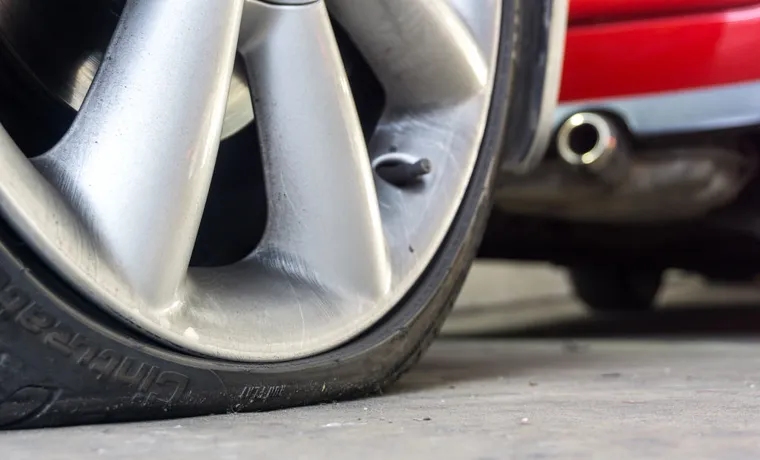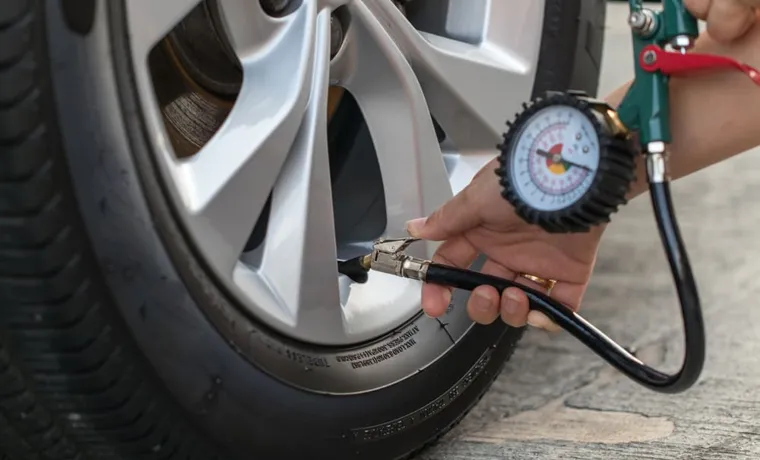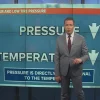Have you ever been driving on the freeway when you suddenly notice your tire pressure is too low? It can be a stressful situation, as low tire pressure can lead to reduced fuel efficiency and a higher risk of accidents. Thankfully, fixing low tire pressure is a quick and easy process that can be done at most gas stations. And with the right tools and knowledge, you can get back on the road in no time.
First, you’ll need to locate the air pump at the gas station. It’s usually located near the front of the station, and it’s often labeled with a sign that says “Air.” Once you’ve found the pump, park your car close enough for the air hose to reach all four tires.
Next, remove the valve cap on each tire and place it in a safe spot where it won’t get lost. Then, attach the air hose to the valve stem and turn on the pump. The pump will fill the tire with air, and you’ll hear a hissing sound as the air enters the tire.
Keep an eye on the tire pressure gauge on the pump and stop pumping when the tire reaches the recommended pressure level, which can be found in your car’s manual or on the driver’s side door jamb. Repeat this process for each tire, making sure to replace the valve cap when you’re finished. Once you’ve checked the pressure in all four tires, take a quick test drive to make sure everything feels normal.
If you still notice any issues with your tires, it may be time to book an appointment at your local tire shop and have them inspect your tires for damage or wear. In conclusion, fixing low tire pressure at the gas station is a simple and straightforward process that anyone can do. With a little bit of know-how and the right tools, you can stay safe on the road and keep your car running smoothly.
Just remember to check your tire pressure regularly and address any issues as soon as possible to avoid any potential hazards on the road.
Table of Contents
Check Tire Pressure
Low tire pressure can be a real hassle, especially when you’re on the road and need a quick solution. Fortunately, most gas stations offer air compressors that you can use to inflate your tires. First, you’ll need to locate the compressor and ensure that it’s working properly.
Then, remove the valve cap from your tire and attach the air hose to the valve stem. Press the lever on the compressor to start filling the tire with air, and keep an eye on the pressure gauge to ensure that you don’t overfill the tire. Once you’ve hit the correct pressure, remove the hose and replace the valve cap.
It’s that easy! Just remember to check your tire pressure periodically to avoid any surprises on the road. By taking a few minutes to refill your tire at the gas station, you can ensure a safer and more comfortable driving experience. So, the next time you encounter low tire pressure, don’t worry – just head to the nearest gas station and get pumped up!
1. Find the Recommended PSI
Tire pressure is an essential aspect of maintaining your vehicle’s safety and fuel efficiency. Checking tire pressure regularly is crucial. The recommended PSI (pounds per square inch) can often be found on the driver’s side door jamb or in the owner’s manual.
It’s important to note that the PSI can differ depending on the vehicle’s make and model, and the type of tire installed. Inflating tires to the recommended PSI can help optimize your vehicle’s performance, including proper handling, steering, fuel economy, and prolonging the lifespan of your tires. Driving on underinflated or overinflated tires can cause unsafe driving conditions, such as poor braking, increased tire wear, and tire blowouts.
Thus, checking and maintaining your tire pressure regularly is critical for both your vehicle’s functionality and your safety while driving.

2. Use a Tire Pressure Gauge
Checking your tire pressure regularly is essential to ensure you have a smooth and safe driving experience. One of the best ways to do this is by using a tire pressure gauge. This tool allows you to accurately measure the pressure inside your tires and make necessary adjustments accordingly.
It’s important to check your tire pressure at least once a month to ensure that they are properly inflated, as under-inflated tires can lead to reduced fuel efficiency and increased wear and tear. Additionally, over-inflated tires can be just as dangerous, as they can lead to blowouts and cause accidents on the road. By using a tire pressure gauge regularly, you can help extend the life of your tires and ensure that your vehicle is running smoothly at all times.
3. Check Pressure When Tires Are Cold
Checking tire pressure regularly is an essential maintenance task that all drivers should perform to ensure the safety and longevity of their vehicle. One important tip to keep in mind is to check the pressure when the tires are cold, before you start driving. The reason for this is that as you drive, the friction between the tire and the road causes them to heat up, which in turn causes the air inside to expand.
This expansion can cause the tire pressure reading to be inaccurate if taken while the tires are still warm. To get an accurate measurement, it’s best to check the pressure first thing in the morning before you start driving. This ensures that you get an accurate reading, making it easier to adjust the pressure if necessary.
By regularly checking the tire pressure, you can improve fuel efficiency, increase tire longevity, and prevent accidents caused by underinflated tires. So, don’t forget to check your tire pressure regularly and always make sure to do it when the tires are cold.
Refilling Tires with Air
If you’ve noticed your car’s tires are running low on air, you can easily fix the problem at any gas station. Simply look for the air pump station, which is usually located near the gas pumps, and follow the instructions on the machine. First, remove the valve cap from each tire and attach the air hose onto the valve stem.
Then, turn on the machine and fill up the tire to the recommended PSI (pounds per square inch). To check the pressure, use a tire pressure gauge which can be found at most gas stations or auto stores. Be sure not to overinflate the tire, as this can be just as dangerous as underinflation.
Once you’ve filled each tire, remove the hose from the valve stem and replace the valve cap. It’s always a good idea to check your tire pressure regularly and keep them properly inflated, as it can improve gas mileage and extend the life of your tires. Next time you’re at a gas station and notice low tire pressure, don’t fret – it’s a quick and easy fix with the air pump station.
1. Locate Air Pump at Gas Station
Refilling tires with air may seem like an everyday task, but it’s essential to keep your vehicle running smoothly. The first step is always to locate the air pump at the gas station, which is usually found near the pump stations. You can easily spot it due to its size and bright colors, and some even have a signpost indicating their location.
Once there, remove the cap from the tire’s air valve, remembering not to lose it. Next, connect the air hose to the valve and turn on the pump. You should monitor the tire’s pressure and stop the compressor once the tire pressure reaches the recommended level.
Remember not to overinflate your tires, as this may lead to instability and reduce fuel efficiency. With this straightforward technique, you can quickly refill your tires with air and avoid the risk of blowouts or poor handling. So, don’t postpone your tire maintenance; instead, make it a priority so you can drive safely on any road.
2. Remove Valve Caps
When refilling your tires with air, the first step is to remove the valve caps. This may seem like a no-brainer, but it’s an important step that people often forget. Valve caps protect the valve stems from dirt and debris, but they can also impede air flow.
By taking them off, you’ll be able to get a better seal with the air chuck and fill the tires more efficiently. Additionally, always keep the valve caps in a safe place while you refill your tires to avoid losing them. Removing the valve caps may only take a few seconds, but it can mean the difference between properly inflated and underinflated tires.
So, take that extra step and remove those valve caps before you start filling your tires with air.
3. Add Air to Tires
Refilling tires with air is an important but often overlooked part of car maintenance. Making sure your tires are properly inflated not only keeps you safe on the road but can also save you money on gas in the long run. The first step is to find out the recommended pressure for your specific vehicle, which can typically be found in the owner’s manual or on a sticker inside the driver’s side door.
Then, you’ll need a tire pressure gauge and access to an air compressor. Simply remove the valve cap, attach the gauge to the valve stem, and take a reading of the current pressure. If it’s too low, use the air compressor to add air until you reach the recommended pressure level.
It’s important to recheck the pressure once the tires have cooled down to ensure accuracy. With properly inflated tires, you’ll have better handling and braking, and your tires will last longer, saving you money in the long run. So, don’t forget to add air to your tires regularly to keep your car running smoothly and safely on the road.
4. Check Pressure Again
After filling the tire with air, the next step is to check the pressure again. This is important because overinflated or underinflated tires can cause issues while driving, such as reduced fuel efficiency and decreased control of the vehicle. To check the tire pressure, you will need a tire pressure gauge.
Simply attach the gauge to the tire’s air valve and read the pressure reading. If the pressure is still below the recommended level, continue adding air until it reaches the appropriate level. If the pressure is too high, release some air until it matches the recommendation.
Once you have achieved the desired tire pressure, securely replace the air valve cap and repeat the process for the other tires. Regularly checking and maintaining tire pressure can help prolong the lifespan of your tires and ensure a safe and comfortable driving experience.
Tips for Maintaining Proper Tire Pressure
If you’re driving and notice that your tire pressure is low, don’t worry! It’s a problem that’s easy to fix, and gas stations typically have the tools you need. First, pull your car up to the air pump, and check the tire pressure recommended for your car in the owner’s manual or on the sticker on the door frame. Then, unscrew the valve cap on the tire and press the air hose fitting onto the valve stem.
Add air in short bursts, checking the pressure often with a tire gauge until it’s at the recommended level. If the tire won’t hold air or keeps losing pressure, it may require a patch or to be replaced entirely. By regularly checking and maintaining your tire pressure, you’ll not only improve the longevity of your tires but also save on fuel costs.
So don’t hesitate to fix low tire pressure at the gas station – it’s a quick and easy task that can make all the difference in the long run.
1. Check Pressure Frequently
Maintaining proper tire pressure is crucial for both safety and fuel efficiency. One of the most important tips for keeping your tires in top shape is to check the pressure frequently. Over time, your tires lose air even if there is no puncture or leak, which can cause them to become underinflated.
Underinflated tires can lead to poor handling, slower braking times, and decreased fuel efficiency. In order to keep your tires operating at their best, it’s recommended that you check the pressure at least once a month, or before long trips. You can easily check the pressure with a tire gauge or take your car to a mechanic or tire shop for a professional evaluation.
By keeping your tires properly inflated and regularly checking their pressure, you’ll be able to maintain optimal safety and vehicle performance.
2. Keep Tires Clean and Free from Debris
Maintaining proper tire pressure is essential for keeping your vehicle safe and optimized for performance. One of the most important tips is to keep your tires clean and free from debris. Any rocks, sticks, or other foreign objects can puncture the rubber and cause a flat tire or worse.
Additionally, cleaning your tires can help you identify any existing damage or wear that may need attention. You can easily remove debris by hand or with a brush, and regular washing can help prevent build-up of grime or brake dust. By regularly inspecting and cleaning your tires, you can help prevent accidents and extend the lifespan of your tires.
Remember, a little maintenance and care can go a long way in ensuring the safety and longevity of your vehicle.
3. Replace Damaged Tires or Valve Stems
Maintaining proper tire pressure is crucial for ensuring not only your safety but also for a smooth and efficient ride. One of the most important things you can do to maintain proper tire pressure is to replace damaged tires or valve stems. A damaged tire or valve stem can cause air to leak, which can result in low tire pressure and, in turn, affect the handling and performance of your vehicle.
It’s important to inspect your tires regularly for any signs of damage, such as cuts, punctures, or bulges. Similarly, valve stems can wear out over time and become damaged, causing air leakage. Replacing damaged tires and valve stems as soon as possible is crucial for maintaining optimum tire pressure and ensuring a safe, smooth ride.
So, if you notice any damage to your tires or valve stems, don’t wait to get them replaced. Your safety and the performance of your vehicle depend on it.
Conclusion
Don’t let a flat tire deflate your spirits! If you find yourself with low tire pressure at a gas station, fear not! With these simple steps, you’ll be back on the road in no time. Just follow the instructions on the air pump, check your tire’s pressure regularly, and remember that properly inflated tires not only save you money on gas, they also keep you safe. So go ahead and fill ‘er up with confidence and be the hero of your own automotive adventure!”
FAQs
What should I do if my car’s tire pressure is low at a gas station?
You can use the gas station’s air compressor to inflate the tire to the recommended pressure level.
How do I determine the recommended tire pressure for my car?
The recommended tire pressure for your car can be found in your owner’s manual or on a sticker on the driver’s side door jamb.
Can I use a tire gauge to check my tire pressure at the gas station?
Yes, you can use a tire gauge to check your tire pressure at the gas station.
What if I don’t have change to use the gas station air compressor?
Some gas stations may offer free air, or you can ask the station attendant to make change for you.
Can low tire pressure cause damage to my car’s tires?
Yes, low tire pressure can cause premature wear and tear on your car’s tires.
How often should I check my car’s tire pressure?
It is recommended to check your car’s tire pressure at least once a month.
Can I drive on a tire with low pressure?
It is not recommended to drive on a tire with low pressure as it can damage the tire and potentially lead to an accident.



